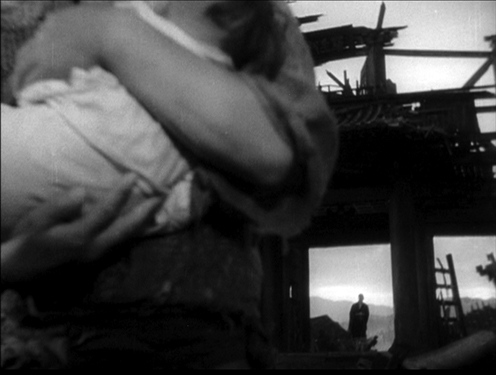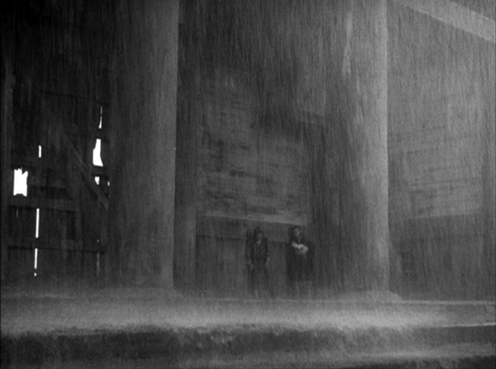

On July 1, 1950, Kurosawa and his composer Hayasaka Fumio met to talk about the sound for Rashomon. They went over Hayasaka’s treatment of Ravel’s Bolero, also the “ghostly music,” Noh theatre style, that was to accompany the voice of the shaman (in a self-critique, Hayasaka once said that his music “moves through mist and fog, not through the real world”). The very next day, word spread among the crew on location in the woods outside Nara that the Kinkaku-ji—The Temple of the Golden Pavilion—in neighboring Kyoto had been lost in a massive fire. There were reports that a deranged novice monk had deliberately set ablaze this monument of medieval Buddhist architecture. On a nearby hill, as the flames blackened the temple’s gilded wood, the novice attempted suicide, details from which Mishima would later spin into one of his greatest novels, bearing this temple’s name, about an overpowering beauty that obliterates mental and moral boundaries.
Kinkaku-ji, having survived the war, was now a charred ruin. Meanwhile, on the back lot of the Daiei studios, a massive, built-to-look “ruined” gate, eerily absorbed within its symbolism this latest tabloid testament to the fleeting nature of beauty in this world and to the madness of men.
Besides Hayasaka, Kurosawa would establish strong working relationships with many other craftsmen in the film industry, especially with fellow screenwriters like Hashimoto Shinobu, who was his collaborator on Rashomon, and later with Oguni Hideo, who added his hand to theirs in the writing of Ikiru and Seven Samurai. Kurosawa must have known that his stubbornness could have woeful effects on a script, given his even stronger felt need to make films not to be contained inside a single genre or to run along a single track. His major work instead reveals a dynamic script collaboration between himself and at least one, often two, at times three other writers.
Even before Seven Samurai, where he started to use multiple cameras to capture action from several different angles simultaneously, Kurosawa entrusted the script—“the banner of the film”—to the multiple perspectives guaranteed by his preferred method for producing a scenario. It called for sequestering himself and his associates in rented rooms for weeks on end, often at a hot springs inn, drafting and haggling over scene after scene, lubricated by beer or sake or whiskey according to the time of day or night, until a composite piece that all could agree on was hammered out.
But his relationship with Hayasaka Fumio, who scored every film Kurosawa made between Drunken Angel (1948) and Record of a Living Being (1955), seems to have been especially intense. Indeed, it was Hayasaka on whom Kurosawa relied to generate what he called the “multiplier effects” of sound (earlier discovered thanks to his mentor Yamamoto, though surely also to his brother, the vocal performer who multiplied the effect of the screen’s silent images). The signs of the tuberculosis that would eventually kill Hayasaka five years later were already manifest in the summer of 1950, as they were making Rashomon together in the sweltering heat of central Japan, shooting on location in a dense cryptomeria forest from whose heights creepily fell legions of blood-sucking leeches.
Hayasaka was revered in music circles and counted among his disciples Takemitsu Toru and Sato Masaru, in whose hands he left the arrangement of the unforgettable score he wrote for Seven Samurai as he was failing, and he again left them with the scant work he was able to do for Record of a Living Being, which was still being shot when Hayasaka died. We note the especially long gaps—silences—in this film, as if in memoriam. Kurosawa would preside at Hayasaka’s funeral, after which he is said to have retreated to a room on the second floor of his home, window shades drawn, and did not emerge for two weeks, so lost was he in grief.
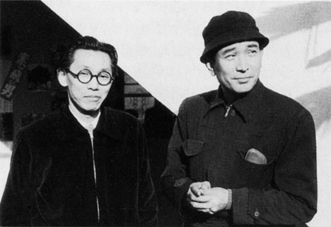
Hayasaka and Kurosawa
Hayasaka had a further connection to Rashomon and to Akutagawa, quite apart from his work on this film with Kurosawa. Another young musician he had championed was Akutagawa Yasushi, one of the author’s sons (another son was Akutagawa Hiroshi, the acclaimed film actor, who plays a ghostly, nonspeaking character in Kurosawa’s first color film, Dodeskaden). When Yasushi learned that his father was Hayasaka’s favorite writer, he presented his teacher with a pencil sketch of a kappa, drawn by Akutagawa himself, based on the hybrid creature featured in the author’s famous Kafkaesque fable (Kappa, 1927). This son would also let Hayasaka know that Akutagawa’s favorite composer was Maurice Ravel.
Early on in Rashomon, we go inside the forest for the first time with the woodcutter, accompanied by Hayasaka’s syncopated rendition of Bolero. The music surges until the woodcutter encounters a scattering of clues. Everything slows at that moment, as the woodcutter begins to search the ground, a wary scavenger. Then Kurosawa stops him cold, capturing the shock and terror on the woodcutter’s face as he stumbles upon a dead body (all we see of it are two arms raised, the fingers splayed and unmoving). Recall another “frozen” moment in Kurosawa’s transcription of such an event, dating to the summer of 1933. “At the entrance of the room I found myself unable to move” is how the memoir describes Kurosawa coming upon his brother’s body, already in rigor mortis, at a country inn.
In Akutagawa’s 1915 “Rashomon,” we encounter a line where he comments on the mental habits of his narrator, who is also a thief: “His thoughts wandered the same path again and again, always arriving at the same destination.” That sentence doubtless describes Akutagawa’s storytelling habits and resonates strongly with Kurosawa’s own narrative returns and encirclings. Ever since that 1933 death scene Kurosawa walked into, the one he called “the story I do not want to tell” and which his memoir never did face directly, Kurosawa had nevertheless kept it alive in memory, perhaps alongside other recollections of the silent era, of what he saw and heard in movie theatres that made him “shudder.” Hayasaka’s music, fraught with its “ghostly” sounds and contrapuntal ruptures, aided Kurosawa in his recovery of a lost medium—silent film—the better to tell stories of other losses, past and present.

How to make the dead speak again? It is a question that echoes throughout Kurosawa’s storytelling. Necessarily, in ways reminiscent of The Cabinet of Dr. Caligari and Nosferatu and The Fall of the House of Usher, whose phantoms once “spoke” at Tokyo movie theatres in Heigo’s voice and accent, there is a haunted quality to most all of Kurosawa’s postwar production. Even the “modern life” films are riven by flashbacks, voice-overs, dreamlike and palimpsest-like montage sequences. Confronted by the hard-edged wipes, the multiple dissolves, the expressionist close-ups, and the staggered, contrapuntal use of instruments and voice, Kurosawa’s visual and sonic style puts us on alert. Look at that world on the screen, Kurosawa seems to say, those intimate details that settle us into some realistic, “everyday” life. Then look and listen again. Recognize that it is a false and partial world, one we share with absent presences, ghostly specters, who belong to another age and who will not release our present from the grip of their past.
In the heightened incidents of their shared life together, shadowed by the arc of Heigo’s rise and fall, we can trace the dramatic arc of Kurosawa’s black-and-white postwar narratives. There is urgency, for Kurosawa, to turn and face a deeply personal past. But at most every turn, his own needs meet up with those of others and intersect with a shared past, marked by earthquake and war, and the collective needs of other survivors. Kurosawa’s films rarely settle for nostalgia or box themselves into a realistic, merely domestic setting (as Wenders noted, he doesn’t do families, “home drama” style). Instead, we encounter their veerings and false starts, and track the necessary fall of a Kurosawa hero not back into any childhood “greenhouse” but into the mud of the wider world outside it.
Kurosawa deftly manipulates irony and melodrama to document his obsessions and his restlessness. But the films derive their focused strength and at times unbearable intensity from his knowing that these tales, not all of them innocent or ultimately redemptive, are not merely literary or cinematic. Inside his twists of plot, the sudden, often tragic turns of his narrations, it is human life as it was loved and lost that we recognize.
In works like Stray Dog and High and Low, the tortured sounds emitted at the end of each film by a charismatic villain come closest to artistically projecting the voice and the darker aspects of his brother’s life in its last extremity. Those fear-filled howls capture what Kurosawa likely imagined to have been Heigo’s final cry. We recall the local newspaper reporting on “the double suicide at Yugashima,” noting it was the overheard excruciating pain of the man and woman who had ingested karumochin along with a dose of rat poison that alerted the innkeeper to call for help. Kurosawa in his memoir holds back many such details of the death scene, including the presence and the name of the woman who would die with his brother in this shinju pact.
There is, further, the memoir’s misleading reference to a “bloody sheet,” as if his brother had used a knife or blade of some sort, in a manner that would render his death more dignified, more samurai or ronin-like. Instead, as Kurosawa surely knew at the time, the drug Heigo had ingested was quite common. Karumochin-induced endings had become something of a craze among the young and the suicidal. There was a long roster of lovers who chose to die in 1932–1933, a peak period for suicides in Japan (amid continuing economic distress and the looming certainty of a massive war), often using the fashionable drug karumochin to do it. Usherettes at that time were directed to patrol the aisles, in an effort to spot and perhaps to prevent a suspicious couple from taking the drug in a darkened movie theatre, a favored place to consummate the act, so far as it was cheaper than renting a room in even a fleabag hotel, much less traveling off to Izu to a hot springs inn.
Had Kurosawa decided to film the tragedy of his brother’s life and death straight on, even he might have lost control of the narrative, as he did when he took Dostoevsky straight on in his version of The Idiot. However tethered his films are to memory or to artful expressions of his own troubled life (incidents of shinkeisuijaku, or “nervous breakdown,” abound in his memoir, and in other biographical anecdotes), Kurosawa took his stand in the mud of the world beyond himself, moved to go there by a strong ethical, if not political, consciousness. He made films from the stuff of personal history, but in a way that cuts into the broader history of his time. However cathartic certain of his films may have been for him, he always intended to force an encounter with his audience, to make us “shudder,” in the first instance. For the sake of those more desperate than he was in the postwar period, he would not allow himself to be narrowly personal or to appear leveled by despair. And so his stories arc across the negative and the positive, darkness and light. In the shadow world between, we find ourselves, with Kurosawa, alive amid the ruins, at once mourning the dead but alert and expectant, prepared to embrace the smallest sign of new life.

After being shrouded by the downpour and by the ruined gate at Rashomon’s beginning, we will step into the delusional brightness of the courtyard and from there be led repeatedly to the crime scene, surrounded by the forest’s deep shadows. There are four witnesses to how the samurai died there. Two testify that he was murdered with a long sword by the bandit Tajomaru; one that he was murdered, but with a dagger by his wife; and still another that he killed himself with a dagger. And so we remain shrouded, in a sense, by contradiction and doubt. As Kurosawa said, once you enter this forest, your heart can go astray.
Kurosawa resorted to silent-film-style allegory and to absurdist farce, not to historical realism, to frame his Rashomon. He could thereby coil around a singular, painful truth, but without making it appear overly centered on his own life. An ironic “distancing” of a kind he knew Akutagawa had used in his own storytelling is also replicated here. For example, in the bandit’s and the woodcutter’s stories about how the samurai was murdered by Tajomaru with a long samurai sword, Kurosawa stages their struggle as one of thrills and spills of a kind we associate with vaudeville or silent film slapstick (Fatty Arbuckle, Buster Keaton, and Harold Lloyd were well known to him). It lightens the tone and certainly undercuts the mystique of the sword or of swaggering machismo.
In the woman’s testimony, when she murders the samurai with a dagger, the mood takes a decidedly more serious, almost noir turn. The force field shifts away from her abusers—the bandit and her husband—toward her, less a victim now than an avenging angel. The bandit who committed the rape has long since fled the scene. But the woman is about to be violated again, by a husband who cares more about his own honor or, as he will later say, for his horse, than for this “fallen woman.”
The woman had earlier shown herself to be agile and aggressive in her resistance to the bandit (until the sun “blinded” her, by his account, and she “yielded” to his aggression, longingly, as the camerawork also implies). But here, the Bolero repetitions are coupled to a slow panning shot, giving luminous, indeed heroic stature, to her face and upper body. She is in motion, with irresistible, hypnotic intent. Her knife is steadied, just below her chin, and it is pointed outward, straight for this husband whose cold rejection she will not abide.
Which brings us to that other rendition of the crime story, the one by which Akutagawa had ended his own literary account of “what happened” in the forest. Here, the repeatedly “murdered” samurai turns out to be a suicide. The segment is highly stylized and theatrical, as if it had been transposed to an impromptu Noh stage. We recall that Noh plays frequently feature the dead, whom we don’t recognize at first because they have assumed a living, human form. Often, though, their backstories reveal that they died violently or unrequited, in a state of profound regret. Banished from mortal life but in such inner turmoil that they cannot go quietly to their graves, they are condemned to a ghostly existence, and to wander across the wastes of time, hoping to find a proper way to have their life and death stories told and listened to again. Such plays are often orchestrated by a traveling priest, who will pray over them for the repose of their unquiet souls.
Kurosawa was surely not alone in the postwar period in telling film stories that gather themselves around a singular death and conform to something like a requiem. We look back and often describe the period when Rashomon was made and films were produced by his remarkable peers Ozu Yasujiro and Mizoguchi Kenji as being the golden age of Japanese cinema. However different their styles or their underlying intentions, these directors commonly feature a scene in some of their finest work that stands as a mourning ritual: the family gathered upon the death of the grandmother in Ozu’s Tokyo Story, a bowl of rice carried to the burial mound of the potter’s wife by her orphaned son in Mizoguchi’s Ugetsu, and the death of the elderly bureaucrat in Kurosawa’s Ikiru—with over one third of the film still remaining—followed by his wake, where he is remembered by multiple eyewitnesses and which lasts until the film’s end.
These Japanese directors all give special, often spiritual, significance to a solitary death at a time when the populace at large had all too recent memories of the dead, in vast numbers, who had been lost to war and to the predations of the twentieth century.
Whatever his experimental, modernist edge, Kurosawa did not shy away from either ritual forms or the monumental. He would structure Rashomon as a grand epic whose magnificence is promised by the set, by the primeval forest, and by the sheer seductive star power of Mifune Toshiro, Mori Masayuki, and Kyo Machiko. The stunning chiaroscuro and the mellifluous sweep of Miyagawa’s camerawork, as well as Hayasaka’s charged and moving score, add to our overall sense of the film’s attentiveness to formal beauty.
But the narrative, in its stops and starts, is repeatedly diverted, subject to swings of mood and tone or breakaway segments leading into something more jumbled, random, or inexplicable (how does the woman, in her full-length kimono, outrun the loincloth-clad bandit who chases after her, not once but twice?). Kurosawa was an admirer of The Threepenny Opera and thought to make a “musical” based on that play, in homage to Kurt Weill and to Bertolt Brecht. The distancing devices he deploys in Rashomon, reminiscent of Brecht’s “alienation effect”—an intermixture of the serious and the absurd—are further evidence of Kurosawa’s lingering attachment to experimental or agitprop art, as he first encountered it as a youth in Tokyo in the late 1920s.
More than the avant-garde, however, it is the melodramatic that Kurosawa relied on most crucially. He was a sentimentalist and a moralist, conscious that art must traffic in good and evil, but in ways less cut and dried than do religions. And so somewhere inside Rashomon we expect him to tell a story in a melodramatic key, where he will silence Bolero and use other, minor chords to drive home the melancholy.
In the story of the dead man, as told to us by the medium, Kurosawa does exactly that. Here, the act of dying is treated with the gravity of a liturgical rite. The dramatic focus on this self-inflicted death serves to isolate the man from the other characters in Rashomon. But this singular death of a man with no name also aligns itself allegorically with the anonymous carnage wrought by the earthquake and the war. Similarly, the conflicting, self-deceiving stories about the forest “crime” remind us of the betrayals and lies that line the cultural and political landscape in wartime Japan, to which Kurosawa admits he had contributed.
As we recall, the charred remains of the “clustered dead” imprinted themselves on Kurosawa’s eyelids as he walked through his lost city after the earthquake in 1923. But one death in Kurosawa’s past, which took place one day in July 1933, was distinct and unforgettable: the suicide of his brother at an inn in the “country,” away from Tokyo. Inside Rashomon, there is indeed one story that calls a special attention to itself. It is the only one which will feature a single actor at the time of death, instead of the three principal actors—bandit, samurai, wife—all three or at least two of whom are conspicuously present throughout the various other accounts of “what happened.” The tale is told by the dead man himself, which its hearers at the gate—woodcutter, priest, and the cynical drifter—listen to, as if to an old ghost story.
To tell the ghost’s—that is, the dead man’s—story, Kurosawa will resort to a vocal style and to stagecraft reminiscent of Noh theatre. As noted, Noh performances proceed with ritual rigor, almost as a liturgy, with exorcism a desired outcome for its slain warriors or lovers, who died before their proper time. Kurosawa introduces in this segment a new character, a miko, or shaman (whose role he will reprise for the forest prophecy scene in his version of Macbeth—Throne of Blood, 1956). For the period of her trance and recitation, the miko lives in two worlds simultaneously. She is present, whirling in the dust of the magistrate’s courtyard during her “witness.” And the samurai is present in her voice, which she is throwing onto the projected images we will see of this forest scene.
In other words, the shaman is performing like a movie commentator—a benshi—standing to one side of the forest “action,” using her voice to express the meanings, apparent or latent, in those silent images. She will provide a clearing and a voice for the one who found himself lost and alone in a forest (just as a benshi like Heigo, in fulfillment of his role, would have used his voice across the gender spectrum and so “become” not just Rudolph Valentino or John Barrymore, but also Lillian Gish or Marlene Dietrich).
We observe how repetitive and necessary clearings are to Kurosawa’s work in black-and-white: the untilled land in No Regrets for Our Youth, the sumps and urban cesspools in Drunken Angel and Ikiru, the vacant urban square in Stray Dog and Record of a Living Being, the circle of dust at the beginning of Seven Samurai that will later turn to mud and become the site of the final battle, perhaps the greatest such scene in all of film history.
Such clearings emerge the more strikingly for all of the entangling details that otherwise fill Kurosawa’s scenes. We notice how often elements of the natural world or of social spaces obscure our vision, stand between us and the apparent object of our scrutiny: all of the leaves and branches in his many forests, the teetering piles of books and papers, the shop screens and beaded curtains, the jostling crowds on the back streets, in the black market, at all the cabarets, honky-tonks, and hole-in-the-wall bars.
It is as if the entanglements are there to provide the actuality and the alibi available to any of us caught up in the details of everyday life. We can’t quite see where we should go, what it is we should do. We are lost in a forest and can’t find the way out, the road ahead. But then comes the clearing, where we are set in a stark, existential face-off, with or against forces which exert a higher claim on us; determine our character because they demand confrontation with usually hidden parts of the world or of ourselves. Even the enemy within.
But there is no clearing anywhere in Kurosawa that opens up quite like this one, with the samurai and the voice of the shaman in the forest. Here, the atmosphere transforms. Gone, as mentioned, are the other main characters, along with Bolero. We see the samurai, free of his bonds but on his knees, and he is weeping. No one hears him, nor would we, if not for the voice of the spectral shaman, herself caught inside the sand-filled courtyard, whirling inside a dance of someone else’s making, embodying for us the last sounds, the last movements of this distant character, alone now in the forest clearing.
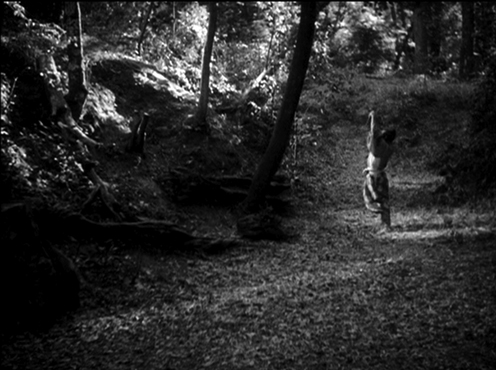
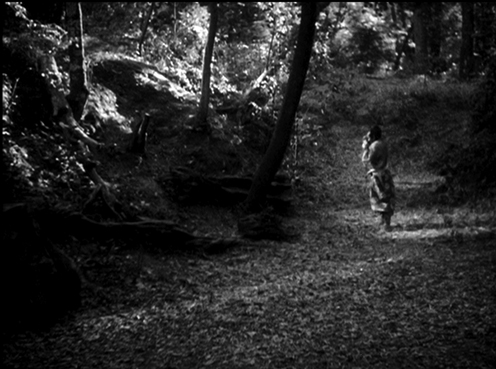
This is of course a death scene, but it is different from the others. There is no long sword and no murderer. Instead, we become witnesses to the final moments of a desperately shame-filled, lonely man. He is about to take his own life, apart from home and family. Yet for the time that Kurosawa takes to shoot this scene, to search out and to find such a man as he is about to die by his own hand, we become his companions, his intimates. We accompany him on his final journey. Led by the haunting beauty of these wordless images, we enter a world gone quiet and rescue the dead from oblivion.
Yet Kurosawa lingers and does not forget the miko, who has been narrating this silent drama for us, as if she were there. She is indeed the most intimate of all possible companions to this man. The samurai’s last thoughts and feelings are those that she is privy to and transmits. We can imagine, then, that she is playing a double role: not just as the benshi-like voice of the samurai, but as the ghost of another woman who once died beside another suicidal man. While we are watching the samurai drive the dagger into his chest and “fall” in the forest, the camera cuts away to the courtyard, where simultaneously the miko’s body twists in pain and collapses, in her own death agony.
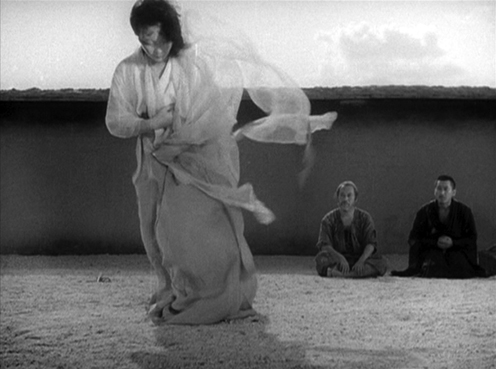
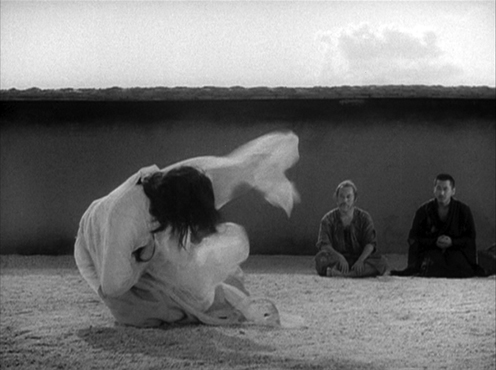
In his memoir, Kurosawa had been unable to tell us what really happened at that inn on Izu. He says nothing about the woman who was with his brother and who carried out her own self-inflicted death beside him. And whereas the miko was merely a narrative voice in Akutagawa’s short story, Kurosawa here gives her a palpable, physical presence.
More than a voice, then, the shaman is also a woman, who falls alongside the man. As if they had committed shinju—double suicide. Whatever requiem Kurosawa is staging in memory of his brother or of the “clustered dead” of the earthquake and the war, he may also be staging it in memory of the woman his brother took away.

All three of Kurosawa’s greatest films—Rashomon, Ikiru, and Seven Samurai—seem to end in a darkness from which there can be no escape, after the deaths of many of its principals, including heroes of such dimension as Watanabe in Ikiru and Kikuchiyo in Seven Samurai. Besides such deaths, the postwar black-and-white films relentlessly trap or corner their characters: implant in them a terminal disease; back them up against social or psychological walls. Yet time and again, before they die, or in their first acts as heroic survivors, they struggle to find the seam of a slim, improbable breakaway. They throw open closed doors and move from an interior darkness toward a suddenly dawning light.
The “requiem” in Rashomon, as it transpires in the dead man’s account, might have brought this film to its proper end, as it did in Akutagawa’s story of the forest crime, where it stood as the last witness. But Kurosawa presses on. He has the woodcutter give his witness, which turns out to be self-incriminating (the evidence and his own botched testimony point the finger at him as the thief of the dagger). So here is our woodcutter, whom we have relied on as our primary storyteller, found out to have lied in his own courtyard testimony. It makes us wonder and takes us back to the beginning of Rashomon. Has he been lying to us all along?
The woodcutter turns out to be one of the criminals, though he had seemed a weak, cast-down character from the first words he uttered at the gate. He was consumed then by a fear he could not name, except to say that the world lay beyond his comprehension, as if he had no place in it. But by the end of the film, whatever paralyzing fear he once felt, whatever cynicism he harbored toward human beings who relentlessly lie to protect their egos, the woodcutter has now turned to face his own criminal self-deceptions. And to the extent he has become conscious of such personal sins of word and deed, he shows himself capable of some further transformation. Indeed we see him begin to rise up, like Lazarus, or like so many flawed heroes in the Kurosawa mold.
The last cry we hear at the gate, to which the woodcutter decisively reacts, comes from a small corner at the back of it, which had heretofore remained out of sight. It is the sound of a crying child, abandoned there, much as Griffith once abandoned children on the steps of the Cathedral of Notre Dame, or as Chaplin left an orphan on the stoop. It is a startling sound and an especially melodramatic insertion at this juncture of the drama.
Kurosawa knew that the scene was yet another “leap.” But he responded sharply to charges that he had here broken faith with the film’s darkness and skepticism. Any true skepticism, he argued, “stays in touch with a desire to believe in human goodness.” Elsewhere, mindful of the widespread desolation and despair that gripped so many in postwar Japan, Kurosawa said simply, “We must believe in humanity, or die.” Only literati want a dark ending. Ordinary people want some light.
Before that child’s cry, darkness and the shadow world had loomed large in Rashomon from the earliest shots. Even if it is always daytime when we enter the forest, the overhang is dense, making us feel that we are enclosed together in a dark room, like filmgoers attending a matinee on a sunny day in a darkened theatre.
But Rashomon, even in these shadow-ridden segments, is lined by flashes of illumination, reflecting off the axe blade, the foliage, the surface of the stream. And Kurosawa has been giving us strong geometries to cling to—circle, triangle, and square—distinct yet bound to each other, as they are in a famous Zen painting. These forms reassure us that even in a ruined world such geometries are still available to our sight. It is Kurosawa’s great gift to make us feel that such forms are not empty or incidental but rather that our seeing them marks a first step toward a picking up the pieces of a shame-filled, strayed, or shattered life.
Working with his cinematographer, Kurosawa sees past the wreckage of the gate and through the forest’s tangles and confusions into the distinct lines and swirls that hold their ground against this disorder: the massive verticality of the gate’s pillars and the forest’s trees; the striated, horizontal layering of the steps in front of the gate; the circles formed by the clouds overhead, by the round ball of sunlight radiating down through the canopy of trees; the triangles formed by the positioning of limbs and bodies, by structural buttresses, or by splintered shards of wood.
And so there is a rightness and indeed a marvelous symmetry to the sudden appearance of the abandoned baby at Rashomon’s end. This child, defenseless against weak and scheming men, is nevertheless embraced by a force that stands up against the ruins and resists the moral collapse everywhere else in evidence. The woodcutter, if only at the end and suddenly, as if it were a Dostoevskyan conversion, discovers an impossible good inside himself. He takes an action eked out in parables that line both Buddhist and Confucian thought. His compassion rescues the innocent—the act that Mencius said defined our humanity. Even in a fallen world, it was Mencius’s claim, so long as we are human, we would reach out to save a child, not just our own but any child, from danger and certain death.
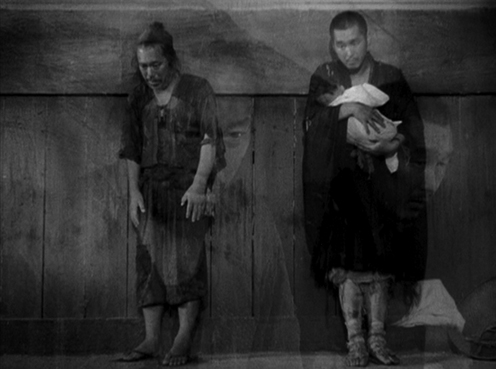
In a haunting sequence of three dissolves, their backs against the wall at the rear of the gate, we see the woodcutter beside the priest, who has taken the child in his arms. They seem to be waiting in silent despair for a being yet to come, like stranded characters in a Beckett play. Finally, the rain lightens, then stops altogether. The woodcutter has no more stories to tell but one important action to take. He will break his silence only to pacify the skeptical priest, who is fearful when the woodcutter reaches out for the child that he means it harm. In the last words he will speak in Rashomon, the woodcutter now tells the priest of his other role, beyond the gate and the forest, where he lives and is a father with six children. So a seventh, he says, will not be too much to bear.
He could be lying here, too. But Kurosawa’s Rashomon has given us a desire, and a hope, to believe him.

From the mid-1940s through the middle of the 1960s, Kurosawa Akira projected onto the screen black-and-white images and geometries shot through with the heightened drama of his personal and family life, as well as the torn and scattered darkness of postwar Japan. Again and again, Kurosawa and his staff built cinematic stories lined in fear and desperation, until from out of the shadows one of his unlikely heroes breaks away. The abandoned baby in the woodcutter’s arms may well be a sign of rebirth, even of Kurosawa’s own lost brother. Just as tellingly, the child testifies to the power of Kurosawa’s will to face his broken world and to labor at rebuilding lost hope and cultural confidence.
And so Rashomon comes to an end at the gate, where Kurosawa had imagined his film at its beginning. We remember that just two figures were visible amid the rain and ruins in those earliest shots. There is a refocus, here again, on just two figures in Rashomon’s final frames. But to sharply counterpoint the driving rain that shadowed Rashomon’s opening, bright sunlight fills the close as the woodcutter, with the child in his arms, walks down the steps and away, leaving the ruins behind.
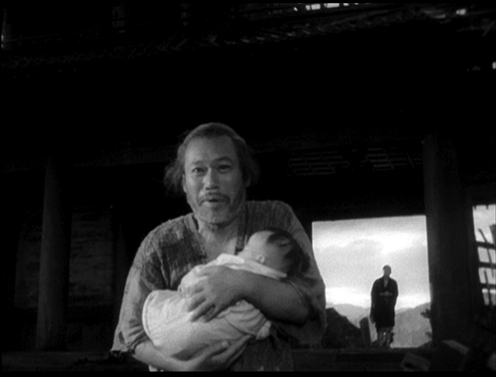
We witness here a once weak and dispirited man no longer back against the wall. He is in motion, as if he felt a calling or heard a voice and was on a mission to save himself and this orphan. We watch him closely, seeing him gain power and momentum with his every sunlit stride through the mud. The camera is tracking backward, moving at the pace of the woodcutter, capturing a joy on his face we had not seen before. Then the tracking stops, the lens still focused on our hero, who keeps walking toward it, until his arm, cradling the child, moves toward collision with the camera—with all of us—as he continues on his way, home.
